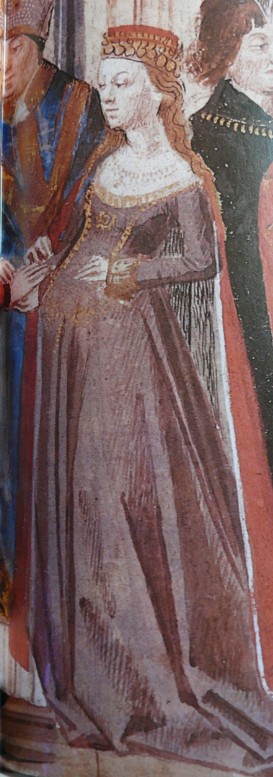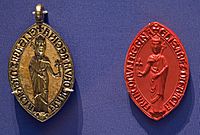Isabelle of Hainaut facts for kids
Quick facts for kids Isabelle of Hainaut |
|
|---|---|
 |
|
| Queen consort of France | |
| Tenure | 28 April 1180–15 March 1190 |
| Coronation | 28 May 1180 |
| Born | 5 April 1170 Valenciennes |
| Died | 15 March 1190 (aged 19) Paris, France |
| Burial | Basilica of St Denis |
| Spouse | Philip II of France |
| Issue | Louis VIII of France |
| House | Flanders |
| Father | Baldwin V, Count of Hainaut |
| Mother | Margaret I, Countess of Flanders |
| Religion | Roman Catholicism |
Isabella of Hainaut was a Queen of France. She was the first wife of King Philip II. Isabella was also a countess in her own right, ruling the area of Artois from 1180 to 1190.
Early Life of Isabella
Isabella was born in Valenciennes on April 5, 1170. Her parents were Baldwin V, Count of Hainaut, and Margaret I, Countess of Flanders.
When she was just one year old, her father promised her in marriage to Henry. Henry was the nephew of Adèle of Champagne, who was also a Queen of France. In 1179, both fathers agreed to this marriage. However, Isabella's father later changed his mind and decided she would marry Philip II of France instead.
Becoming Queen of France
Isabella married King Philip II on April 28, 1180, in a town called Bapaume. She brought the land of Artois with her as a special gift for the marriage, known as a dowry. Her uncle, Philip, Count of Flanders, helped arrange this important marriage. He was a trusted advisor to the King.
Isabella was crowned Queen of France on May 28, 1180, at the Saint Denis Basilica. People at the time believed this marriage was very special. Isabella's father, Baldwin V, was a descendant of the famous ruler Charlemagne. So, the marriage was seen as joining two important royal families: the Carolingian and the Capetian families.
The previous queen, Adèle of Champagne, was not happy about this wedding. It meant her nephew was no longer going to marry Isabella, and her family's influence in the kingdom became less.
Even though some writers praised Isabella, she found it hard to win King Philip's full affection. This was partly because she had not yet given him a son to inherit the throne, even though she was only 14 years old.
In 1184, King Philip was fighting a war against Flanders. He was angry that Isabella's father, Baldwin, was supporting his enemies. Because of this, King Philip wanted to end his marriage to Isabella. He called a special meeting in a town called Sens to discuss this.
According to a writer named Gislebert of Mons, Isabella then went into the town's churches. She walked barefoot and dressed simply, showing she was sorry for something, even though she had done nothing wrong. This made the people of the town feel very sorry for her. Their sympathy grew so strong that they went to the palace and shouted loudly enough for the King to hear them.
Robert, the King's uncle, stepped in and helped. He convinced the King not to end the marriage. If the King had ended the marriage, France would have lost the land of Artois, which was Isabella's dowry. Finally, on September 5, 1187, Isabella gave birth to a son, who would become King Louis VIII of France. This was the heir the King needed.
Death of Queen Isabella

Isabella's second pregnancy was very difficult. On March 14, 1190, she gave birth to twin boys named Robert and Philip. Sadly, Isabella died the very next day due to problems from childbirth. She was buried in the Notre Dame Cathedral in Paris. She was not even 20 years old. People in the capital city were very sad about her death because she had been a well-liked queen.
Her twin sons lived only four days, both dying on March 18, 1190. Isabella's son Louis became the new Count of Artois. After King Philip died, Isabella's dowry of Artois eventually became part of the French Crown when her son Louis became king.
See Also
 In Spanish: Isabel de Henao para niños
In Spanish: Isabel de Henao para niños


